
Idyllic bush camp in Nth Qld. Author’s 1974 Kombi’s 100-watt solar easily ran its lighting,water pump, radio, etc. Pic: caravanandmotorhomebooks.com
Our editor, a true gentleman and scholar, requested this general guide to power systems for typical RVs (caravans, motorhomes of 5-8 metres under 5.5 tonne). Larger RVs require a similar approach but have space for more solar, and weight capacity for batteries and inbuilt generators.
There are two main approaches: the first uses individual components but necessitates expertise in their selection, interconnection and optimising crucial interactions.
The second uses battery management systems that, by combing functions, compatibility is inherent and interactions made automatically. As most RV electrical problems are due to faulty connections reliability is enhanced.
DO I NEED SOLAR?
If spending most nights in caravan parks there is little point in installing solar. It’s simpler and cheaper to charge a battery overnight from 230 volts (that you pay for anyway) to cope with odd nights sans grid power. If driving most days and rarely staying in one place more than two nights, minor solar usefully supplements alternator charging.
For those extensively free camping, understand (or accept!) there’s no such thing as a free lunch. It has to be paid for somehow. You must, on average, have more energy coming in than going out - plus a margin to cope with charging losses, etc.
For most RVs, roof space limits that run from solar alone. Further, RVs in year-round use are unlikely to have average solar input in excess of 4 kilowatt hours a day. It’s rare to have zero, but 1-1.5 kilowatt hours a day is common when overcast.
As typical two-bedroom homes use 15-18 kilowatt hours a day, claims of 24/7 air conditioning, all-electric cooking and water heating from RV solar alone (in any but larger converted coaches) are absurd. Their generator and/or umbilical 230 volt cord tends to be unmentioned.
WHAT’S FEASIBLE TO RUN IN AN RV GENERALLY?
Using LP gas or diesel for anything that primarily produces heat, slashes needed electrical and battery capacity. Such space and space/water heaters are efficient, reliable and effective. They are available from Webasto, Dometic, Truma, etc.
Fridges: a compressor fridge typically draws 60% plus of daily RV electrical energy. Year-round operation is not feasible from solar alone. A good compromise is 85-90% solar plus generator and battery charger for the remainder. The most efficient fridges are made for home use (Mielle is a quality example). Many ‘RV fridges’ are modified such units, but most are rugged enough for typical RV use.
A ‘T or ST-rated’ (12/230 volt/LP gas) fridge run on gas (away from 230 volts) slashes otherwise needed solar/battery capacity, offsetting the fridges’ higher cost (no generator is needed). Such fridges work well but must be correctly installed. A typical such RV fridge runs for about three weeks from a 9 kg gas cylinder. The high 12-volt draw limits such use to lunch-time stops, etc. The best known (globally) are Dometic.
Regardless of type, effective cooling and energy draw depends on competent installation. Have one large fridge - not two of half that volume. The latter increases energy draw by up to 50%.
Television: the second greatest daily draw is usually a TV. A good post-2014 (230 volt) 20-inch LED TV run via an efficient inverter draws less energy than most 12-inch 12-volt TVs. Upgrading may save more than that cost.
Lighting: LEDs’ efficiency far exceeds that of other lighting, but specifying wattage needs a new approach. Most people under 30 ‘know’ the light level of incandescent globes, but their wattage is of energy drawn, not light produced. LED efficiency varies considerably. The light output per watt of cheapies may be 30%-40% of a top grade LED (e.g. Cree). Good 5-watt LEDs now cost about $15 and produce much the same light as 50-60 watt incandescents.
Most LEDs’ output is concentrated in a 30°-140° cone with little outside that but reflection from light-coloured surfaces provides background lighting. A typical RV is likely to need five or six high quality 5-7 watt LEDs. As their efficiency improves, needed wattage will decrease.
Cooking: gas or diesel induction cook tops (from Webasto and Dometic) are preferred for solar equipped RVs. As with LP gas/230/12 volt fridges, their use slashes needed solar and battery capacity.
A typical ‘800 watt’ microwave oven draws 1350 watts via an inverter: acceptable for 5-10 minutes in typical RVs, but borderline in small ones unless from grid or generator power.
Water pumps: Most pre-2012 pumps are noisy. None is totally silent but variable speed pumps (such as SHURFLO) are quiet. Virtually all are 12 or 24 volts dc.
Air conditioning: The currently most efficient (2500 watt) air conditioner, Daiken’s US7, draws 10 kWh/day at its rated cooling capacity: twice the daily input of most RV solar systems. It is feasible to have 24/7 operation in a large truck or coach conversion but, unless the generator runs all night, needs generator power and plus-750 Ah battery capacity. Or usage confined to an hour or three each evening.
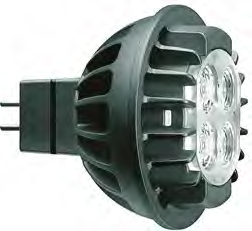
Philips 7 watt LED has 700 beam angle. Pic: Philips
ELECTRICAL ENERGY USED – AND REQUIRED
A watt/hour is a measure of energy usage over time. If run for 1 hour that pump draws 60 watt hours. A simple way to measure this is via a power meter. Good ones cost $30 upwards (Jaycar, etc). They plug into a 230-volt outlet and show watts draw when an appliance, in turn, is plugged into them. (It’s well worth taking one when shopping for 230 volt stuff). Energy draw can also be found by looking at makers’ specifications, or readily estimated from the constantly updated listing in Caravan and Motorhome Electrics.
Table each item, in watt hours of probable daily usage. Their total is average minimum energy you must harvest each day.
REALISTIC ENERGY FROM SOLAR
Solar module daily input is not that claimed times hours of sunshine. It is measured much as is daily rainfall. Solar energy is collected in a ‘light bucket equivalent’ of a rain gauge. Depending on light intensity, that ‘solar bucket’ may fill in an hour across much of Australia on clear summer days, but needs over half a day in Melbourne’s mid-winter. Each ‘full bucket’, known by the industry as 1 Peak Sun Hour (1 PSH), is the equivalent of 1000 watts of (sunlight) energy on 1.0 m2 of our Earth’s surface.
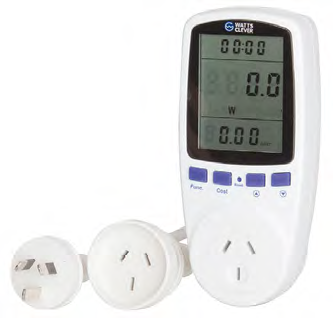
Energy meter. Pic: Jaycar
SOLAR GYMNASTICS
The solar industry has two sets of scales. That for development and marketing (Standard Operating Conditions – SOC) is only laboratory replicable. It is akin to being atop a high equatorial mountain on a freezing cold day in mid-summer with a nominally 12-volt solar module directly feeding a 17-volt or so load.
The second set of scales - Nominal Operating Cell Temperature (NOCT), reflects user reality. Typical NOCT output is 71% of that seemingly claimed. This is revealed in the specifications, and on some modules. The accompanying pic reveals the promoted ‘120’ watts is a likely 83 watts. The industry defends this as ‘traditional practice’. (As is thieving in the burglary trade?)
On a typical 25° C day assume solar output via a basic RV solar regulator is 70% of that seemingly claimed.
Or 80-85% via the so-called MPPT solar regulator built into battery management systems and high quality solar regulators. These do not gain energy, but recover some otherwise lost.
Probable solar energy input output from typical quality monochromatic solar modules is about 140 watts per square metre. The yearly Australian average is about 3.5 PSH/day. Summer average is 5-6 PSH.
Typical RVs have about 1.2 m2 of usable roof per metre of length, limiting input to about 1200 watts (1.2 kW). Excluding the extreme south, realistic average input for a 7 metre RV is 3.6-4.2 kWh/day. Summer input is a probable 6 kWh/day. If energy usage (allowing for 20% loss) is higher than this you must reduce that usage and/or use a fuel cell or generator to add that lacking. Battery storage is covered later in this article.
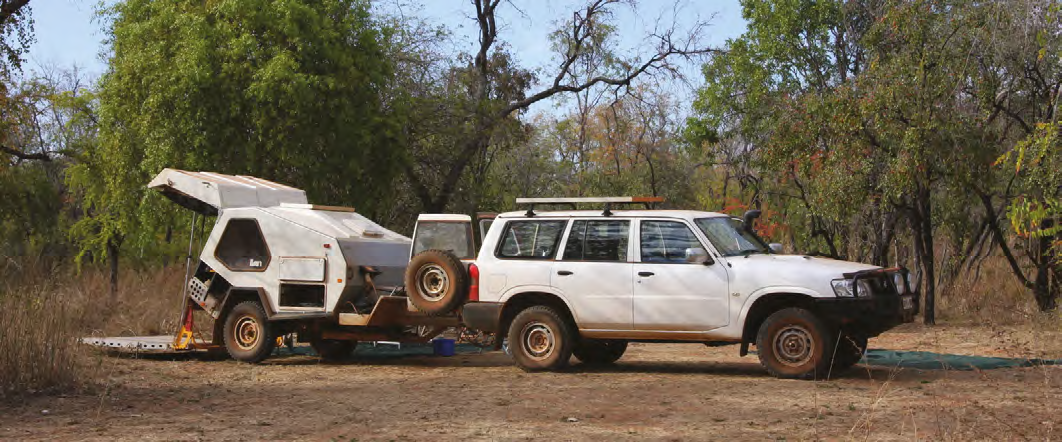
My Nissan Patrol and Tvan each has its own (independent) solar. This works well also for fifth-wheel caravans. Mitchell Plateau 1998. Pic: caravanandmotorhomebooks.com
ALTERNATOR CHARGING
The realistic maximum alternator output for a typical motor home (or tow vehicle) is about 70 amps for standard units, and 100 amps for upgrades. That available for battery charging is about 40 amps and 60 amps respectively. If driving for (say) five hours a day (and allowing for charging loss) that’s 2400 and 3600 watt hours/day. Not all batteries, however, are able to accept that rate of charge. (See Batteries – right).
GENERATORS
Ultra-cheap generators are noisy and polluting. Their use close to other campers is anti-social. Those nearby may protest. Also consider this: Their output is electrically filthy. It can and does damage or wreck electronic equipment particularly when the genny is starting and spluttering to a halt.
The Honda/Yamaha/Robin range of inverter/generators, however, produce clean 230 volts ac and 12 volts dc. The latter is usually an unregulated 13.6 volts at up to 8 amps. It is intended to drive 12-volt appliances directly. That voltage can only partially charge most batteries, and then very slowly. Instead, use a mains battery charger from the generator’s 230-volt output.
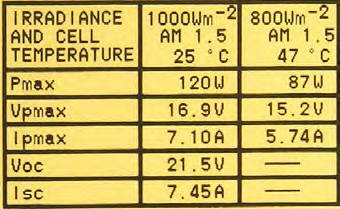
Column 3 reveals the ‘120’ watt NOCT output is a likely 83 watts. caravanandmotorhomebooks.com
FUEL CELLS
Fuel cells produce electricity from fossil fuels electro-chemically. While not realistically affordable as the main source of RV power, unlike petrol generators, their fuel usage is closely related to energy drawn. They are also virtually silent and non-polluting. They seem an ideal energy back-up but it’s increasingly difficult to forecast when truly affordable ones will be available.
That promising most was Truma’s VeGA LP gas unit. Announced in 2005, availability was ‘real soon now’. That morphed into 2007, 2008, 2009 … it was displayed at RV shows in 2011 and became available in 2012. It was an excellent product, but despite heavy subsidies, its 10,000 Euros was too high. That, plus increases in component prices, caused production to cease in 2014.
Third world countries are a huge market for such fuel cells. As slashing pollution is vital, cost-viable fuels cells will emerge, but when?
The main fuel cell for RVs (EFOY) runs from methanol bought from its vendors to maintain warranty. Originally sold via Webasto, their price doubled in 2012, and is now $7000-$10,000.
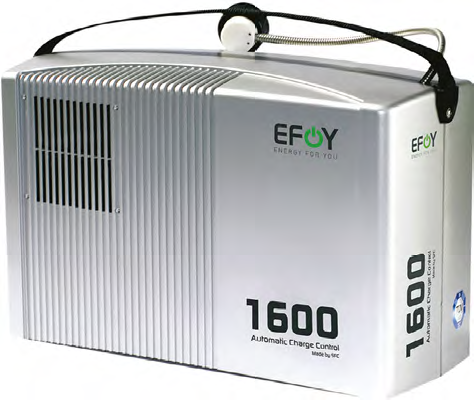
Fuel cell. Pic: EFOY
ENERGY STORAGE
Unless powered via an ultra-quiet generator, (e.g. Onan), an RV away from grid power needs battery storage. There is ongoing debate about assessing how much is required and/or feasible. As a general and practical guide, RVs in daily use need their batteries fully charged by noon most year-round. Attempting this from solar alone is often unrealistic if there is a compressor fridge. If, however, you have a three-way fridge and rarely use a microwave oven, solar-alone is feasible.
BATTERIES FOR RVS
So far this article has mostly referred to energy, and the amount required. Energy is often confused with power – with batteries this matters.
Power is the rate at which energy is used. A typical starter motor draws 350 amps (4800 watts). But as it’s only for 2-3 seconds, the energy used is about 4 watt hours: less than a 5-watt LED for an hour.
Discussing batteries necessitates using amps and amp hours. An amp is a unit of current flow. An amp hour is 1 amp drawn for 1 hour. This can also be shown in watt hours, but is voltage related. One volt times one amp is one watt. A 12-volt (5 amp) water pump run for one hour draws 5 amp hours (5 Ah) - 60 watt hours (60 Wh).
Deep-cycle batteries are traditionally rated by their ability to supply 5% of their energy for 20 hours before (for a 12-volt battery) their voltage drops below about 10.6 volts. They are not then ‘flat’ - but close to so being.
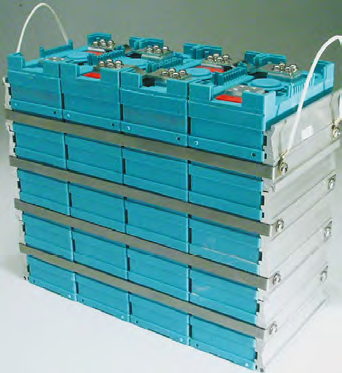
12 volt 100 amp hour LiFePO4 battery. Pic: evPower
A 100 amp hour, 12-volt cycle, leadacid deep-cycle battery, virtually by definition, can supply 100 amp hours. It cannot, however, release starter motor levels of amps for long - its voltage falls too low to support that load. It still has ample energy but now lacks power. A 100 amp hour AGM battery can deliver two to three times that of such batteries. Starter batteries have appropriately different innards. Most are accordingly rated in terms of their power (in Cold Cranking Amps).
LIFEPO4 BATTERIES
In RV use, lithium-ion (LiFePo4) batteries’ remain between 13.1-12.9 volts much of the time, dropping steeply below about 20% charge. In RV use their voltage is barely affected by load. They provide both energy and power. They must have adequate cell management, and be charged in their correct regime. Establishing this is not easy: ‘there can be a lack of clarity when it comes to their charging’ states Mastervolt (who sell them).
A LiFePO4s’ size and weight is one third of comparable capacity conventional batteries. This is important in a typical RV, less so in a coach conversion.
Any but unconditional praise of lithium batteries invariably generates more user outrage than some can demonstrably contain. Their vendors, however, are now more restrained. ‘In typical RV use a bank of 300-400 amp hour AGM batteries will give much the same results as the equivalent LiFePO4 batteries - at well under half the price,’ (states a leading LiFePO4 vendor).
PUTTING IT ALL TOGETHER
It needs knowledge and experience to choose charging system units and have them work together. Care too is essential with interconnections.
Unless really well done, using an RV chassis as a common negative return often results in hard to locate faults. These tend to surface after a year or two, and are often intermittent. Twin core flexible cable is preferable.
As stressed in Caravan & Motorhome Electrics (that also shows how) keep voltage drop under 0.2 volt and 0.4 volt (for 12/24 volt systems respectively).
Be aware that auto cable (sold by auto-parts stores etc) rating is not the conductor’s size. If ’4 mm’, that is the size hole needed to just push it through (truly).
Top quality RV cable is available from Springers Low Voltage Specialists and marine electrical suppliers – but rarely from auto parts or hardware stores.
It increasingly makes sense to have energy input: alternator, solar, grid, etc. - and charging) done by a Battery Management System (BMS), a compact unit that accepts various inputs. BMS systems control interconnections internally, ensuring optimum operation. Many include top quality battery chargers.
Such systems may seem costly, but are simpler (and cheaper) to install. In reality they cost little more than similar quality individual units.
RV electrical faults mostly relate to interconnections. As those in a BMS are internal, reliability is thereby enhanced.
Redarc’s very first BMS (number 01) worked flawlessly for nine two-way crossings of Australia via the Centre, plus thousands of kilometres of corrugated dirt roads where we lived (in the Kimberley). It now handles our solar fishpond pump and lighting.
Battery management units are also made by Sterling (UK), CTEK Projecta, GSL, etc. - in various input capacities. Consider buying larger than needed to cope with any later increase in charging capacity (as solar module efficiency increases).
INSTALLING – WHO CAN DO WHAT?
One need not be an expert (or be licensed) to work with (a ripple free dc) under 120 volts, but it requires trade skills and knowledge. If you lack these, seek help from someone who has. All work over 50 volts ac must be done by licensed electricians. That, for RVs, must accord with Australian Standard AS/NZS 3000:2008 as Amended in 2012.
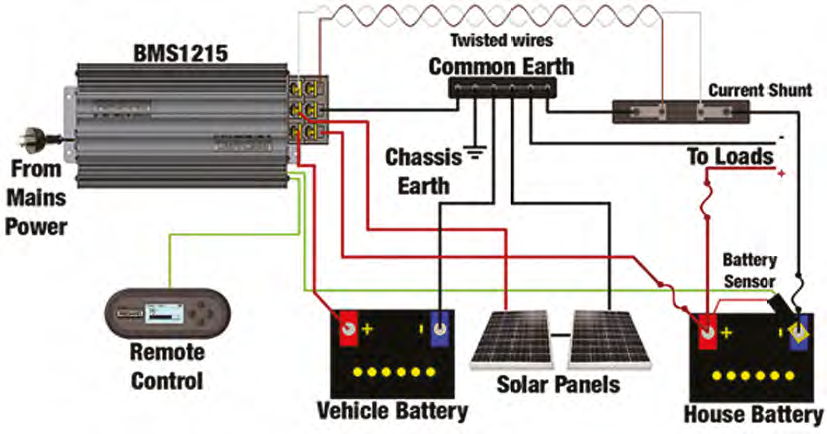
How a typical BMS is installed. Pic: Redarc
CONVERTER SYSTEMS
Many RVs have marginal cable sizes on the assumption they mainly overnight using 230 volt power. Over 80% of all locally sold RVs have ‘converters’ that change 230 volts to a nominal 12 volts (in reality 13.65 volts on light loads). When 230 volts is available, all 12-volt loads run directly from this unit. A backup battery is charged via this unit, but only switched into use if/when 230 volts is unavailable.
Typical converter output is thus higher than from a fully-charged 12-volt battery under light load. Because of this, lighter cabling (that may drop a volt or more) may be used. This is fine when the converter has 230 volts, but when not; items like fridges have little over 12 volts even from a fully charged battery. Converters are simple and rugged - but most are unsuitable for free camping. For solutions see: http://caravanandmotorhomebooks.com/electrical-converter-in-RVs/
INSTALLING LIGHTING
LEDs draw so little energy that any existing wiring will be fine. For new LED wiring, 1.5-2 mm2 is fi ne for up to six or so (5-7 watt) LEDs. Coaches with more LEDs may need 2.5 mm2.
INSTALLING FRIDGES COMPETENTLY
Unless competently installed, compressor fridges cool inadequately and use excess energy, three-way fridges may work to a point on 230 volts but poorly on 12 volts. Their hot weather cooling suffers; gas usage is often excessive.
Most RV fridges have finned cooling tubes at their rear. Cool air must not just flow, but be directed by baffles through these fins. Rising warmed air must be vented to the exterior from well above the highest fin.
A few fridges dissipate heat via their metal sides. These too need cold air at their base. They must have a (50 mm) air gap at their sides. Rising hot air needs venting to the exterior. A small extractor fan assists.
Three-way fridges are intended to be run from the alternator while driving, battery powered during short lunch time stops, 230 volts when available and LP gas at all other times. Depending on size, they draw 10-30 amps on 12 volts, requiring heavy wiring.
For caravan use, install a dc-dc alternator charger (or BMS system) close to the caravan battery. At least 10 mm2 cable is required from alternator to battery.
Dc-dc charging is discussed in http://caravanandmotorhomebooks.com/dcdc-charging/. Its function is included in battery management systems.
This 4.5 page article can only be a summary. It is impossible to cover that which takes up close to 100 A4 pages in my books. I am, however, preparing a series of constantly updated fully detailed instructional articles that can be downloaded, at low-cost, from my website (caravanandmotorhomebooks.com). The first, covering fridge installation, should be available by the time this CMCA article is published.
COLLYN RIVERS
Collyn’s books are available directly from CMCA NHQ. If you found this general article of interest, my books will be even more so. They are currently Caravan & Motorhome Electrics, Solar That Really Works! (for RVs), Solar Success (for homes and properties) and the just released all new Caravan & Motorhome Book. Our website is caravanandmotorhomebooks.com.
Category: Technology
Written: Sun 01 May 2016
Printed: May, 2016
Published By: